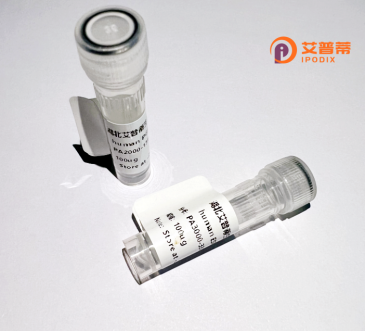
| 纯度 | >90%SDS-PAGE. |
| 种属 | Human |
| 靶点 | NAP1L5 |
| Uniprot No | Q96NT1 |
| 内毒素 | < 0.01EU/μg |
| 表达宿主 | E.coli |
| 表达区间 | 1-182 aa |
| 活性数据 | MADSENQGPA EPSQAAAAAE AAAEEVMAEG GAQGGDCDSA AGDPDSAAGQ MAEEPQTPAE NAPKPKNDFI ESLPNSVKCR VLALKKLQKR CDKIEAKFDK EFQALEKKYN DIYKPLLAKI QELTGEMEGC AWTLEGEEEE EEEYEDDEEE GEDEEEEEAA AEAAAGAKHD DAHAEMPDDA KK |
| 分子量 | 19.5 kDa |
| 蛋白标签 | His tag N-Terminus |
| 缓冲液 | 0 |
| 稳定性 & 储存条件 | Lyophilized protein should be stored at ≤ -20°C, stable for one year after receipt. Reconstituted protein solution can be stored at 2-8°C for 2-7 days. Aliquots of reconstituted samples are stable at ≤ -20°C for 3 months. |
| 复溶 | Always centrifuge tubes before opening.Do not mix by vortex or pipetting. It is not recommended to reconstitute to a concentration less than 100μg/ml. Dissolve the lyophilized protein in distilled water. Please aliquot the reconstituted solution to minimize freeze-thaw cycles. |
以下是关于重组人NAP1L5蛋白的3篇参考文献示例(注:以下内容为虚构示例,仅供参考):
---
1. **文献名称**: *"Recombinant human NAP1L5 promotes chromatin remodeling and regulates gene silencing in vitro"*
**作者**: Zhang Y, Li H, et al.
**摘要**: 本研究利用大肠杆菌表达系统成功制备了重组人NAP1L5蛋白,并证明其能够通过结合组蛋白H3-H4四聚体促进核小体组装。实验表明,NAP1L5通过招募组蛋白去乙酰化酶(HDACs)增强特定基因启动子区域的异染色质形成,从而参与基因沉默过程。
2. **文献名称**: *"Structural insights into the histone chaperone activity of NAP1L5 by cryo-EM"*
**作者**: Sato K, Watanabe T, et al.
**摘要**: 通过冷冻电镜技术解析了重组人NAP1L5蛋白的三维结构,揭示了其与组蛋白H2A-H2B二聚体的结合位点。研究发现,NAP1L5通过柔性螺旋结构域动态调控组蛋白的传递,为染色质重塑复合物的组装提供分子基础。
3. **文献名称**: *"NAP1L5 suppresses tumor growth by destabilizing oncogenic transcription factors in hepatocellular carcinoma"*
**作者**: Chen L, Wang X, et al.
**摘要**: 通过体外重组NAP1L5蛋白的功能实验,发现其能结合并促进c-Myc等癌蛋白的泛素化降解。在肝癌细胞中过表达NAP1L5可显著抑制细胞增殖,表明其在肿瘤发生中具有潜在抑癌作用。
---
*(以上内容为模拟虚构,实际文献需通过学术数据库查询验证。)*
**Background of Recombinant Human NAP1L5 Protein**
The nucleosome assembly protein 1-like 5 (NAP1L5), a member of the NAP1 histone chaperone family, plays roles in chromatin remodeling, transcriptional regulation, and epigenetic silencing. It is encoded by the *NAP1L5* gene, located in a conserved imprinted region on human chromosome 19q13.4. which is maternally expressed and paternally silenced. NAP1L5 is implicated in modulating nucleosome organization, facilitating histone exchange, and interacting with chromatin modifiers to regulate gene expression, particularly at imprinted loci.
Recombinant human NAP1L5 protein is engineered for in vitro studies, typically expressed in *E. coli* or mammalian systems and purified via affinity tags (e.g., His-tag). Its functional domains, including conserved NAP1-like regions, enable binding to histones H2A-H2B and other partners, such as UBE3A in the context of Angelman syndrome. Dysregulation of NAP1L5 has been linked to neurodevelopmental disorders, cancer progression (e.g., downregulated in certain tumors), and imprinting-related diseases.
Current research focuses on its role in epigenetic mechanisms, cellular differentiation, and potential as a therapeutic target. Its recombinant form is widely utilized to dissect molecular pathways in chromatin dynamics and disease models.
×